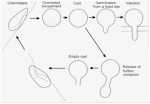..
CHAPTER 10: FUNGAL SPORES, SPORE DORMANCY AND SPORE DISPERSAL This chapter is divided into the following major sections: general
features of fungal spores
SAMPLE TEXT: Fungi are the supreme examples of spore-producing organisms. They produce millions of spores, with an astonishing variety of shapes, sizes, surface properties, and other features – all precisely matched to the specific requirements for dispersal and/or persistence in different environments. A small part of this diversity is illustrated in Fig. 10.1, for some of the more bizarrely shaped spores of the freshwater aquatic fungi that grow in fast-flowing streams. But even the common rounded spores of fungi have properties that determine whether they will be deposited on plant surfaces, or on soil, or in the human lungs, etc. In this chapter we discuss several examples of this fine-tuning, and we will see that the properties of a spore tell us much about the biology and ecology of a fungus.
Fig. 10.1. Examples of tetraradiate, multiple-armed and sigmoid spores found in fast-flowing freshwater streams. Approximate spore lengths are shown in parentheses. (a) A single conidium of Dendrospora (150-200 Ám); (b) conidium of Alatospora (30-40 Ám); (c) conidium of Tetrachaetum (70-80 Ám); (d) conidium of Heliscus (30 Ám); (e) conidium of Clavariopsis (40 Ám); (f) conidium of Lemonniera (60-70 Ám); (g) conidium of Tetracladium (30-40 Ám); (h) conidium of Anguillospora (150 Ám) AIR SAMPLING DEVICES AND HUMAN HEALTH The respiratory tract of humans and other animals is a natural spore-trapping device, as people with allergies know only too well. The respiratory tract is also the route of entry for spores of several fungal pathogens of humans, discussed in detail in Chapter 16. Three mechanisms of spore deposition in the respiratory tract are important: impaction, sedimentation, and boundary layer exchange. During each intake of breath the air speed is fastest in the nose, trachea and bronchi (about 100 cm sec-1) and it diminishes with successive branching of the bronchioles. Therefore impaction will only occur in the upper respiratory tract, where the air speed is fastest, and only the heaviest (largest) spores will have sufficient momentum to impact. The hairs in the nostrils are narrow and covered with mucilage, making them highly efficient for intercepting the larger fungal spores and pollen grains. Some of these airborne particles cause rhinitis and other typical symptoms of hay-fever. All other particles that are too small to impact will be carried deep into the lungs and reach the terminal bronchioles and alveoli. This includes most particles of 4-5 Ám diam or less, including the spores of many common airborne fungi. Most of these spores are expelled again, but a few will settle onto the mucosal membranes by sedimentation during the brief period (usually less than 1 second) when the air in the alveoli is static between inhalation and exhalation. Particles even smaller than this, including the airborne spores of actinomycetes (1-2 Ám diam), can be trapped by boundary layer exchange. The airborne spores of potentially pathogenic fungi such as Aspergillus fumigatus, Blastomyces dermatitidis, Histoplasma capsulatum and Coccidioides spp. can settle in the alveoli by sedimentation, as do the spores of several other Aspergillus and Penicillium species. Some of these fungi, such as Aspergillus clavatus, cause acute allergic alveolitis in people who have been repeatedly exposed to spore dusts and have become sensitised. Several occupational diseases are of this type – farmer’s lung, malt-worker’s lung, etc. Once a spore has been deposited in the alveoli it persists until it is engulfed by a macrophage. In contrast, the upper regions of the respiratory tract are lined with ciliated epithelium which continuously sweeps mucus upwards and removes any particles deposited there. The importance of airborne spores in relation to crop pathology, human ailments and air quality in general has led to the design of air-sampling devices for the monitoring of spore loads. In this chapter we consider the main types of device and the principles on which they operate.
|
||||||||||||||||||||||||











































